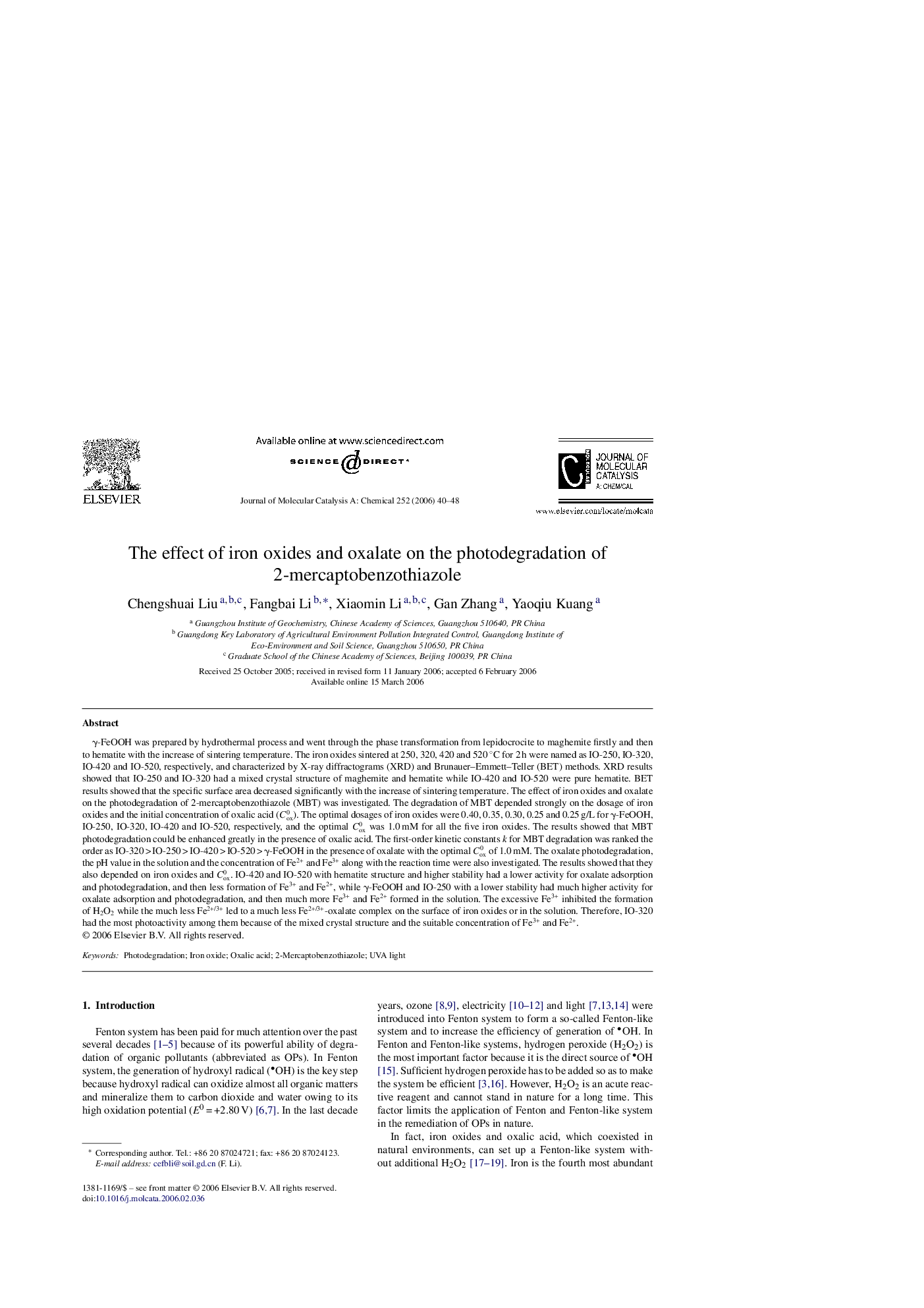| Article ID | Journal | Published Year | Pages | File Type |
|---|---|---|---|---|
| 68966 | Journal of Molecular Catalysis A: Chemical | 2006 | 9 Pages |
γ-FeOOH was prepared by hydrothermal process and went through the phase transformation from lepidocrocite to maghemite firstly and then to hematite with the increase of sintering temperature. The iron oxides sintered at 250, 320, 420 and 520 °C for 2 h were named as IO-250, IO-320, IO-420 and IO-520, respectively, and characterized by X-ray diffractograms (XRD) and Brunauer–Emmett–Teller (BET) methods. XRD results showed that IO-250 and IO-320 had a mixed crystal structure of maghemite and hematite while IO-420 and IO-520 were pure hematite. BET results showed that the specific surface area decreased significantly with the increase of sintering temperature. The effect of iron oxides and oxalate on the photodegradation of 2-mercaptobenzothiazole (MBT) was investigated. The degradation of MBT depended strongly on the dosage of iron oxides and the initial concentration of oxalic acid (Cox0). The optimal dosages of iron oxides were 0.40, 0.35, 0.30, 0.25 and 0.25 g/L for γ-FeOOH, IO-250, IO-320, IO-420 and IO-520, respectively, and the optimal Cox0 was 1.0 mM for all the five iron oxides. The results showed that MBT photodegradation could be enhanced greatly in the presence of oxalic acid. The first-order kinetic constants k for MBT degradation was ranked the order as IO-320 > IO-250 > IO-420 > IO-520 > γ-FeOOH in the presence of oxalate with the optimal Cox0 of 1.0 mM. The oxalate photodegradation, the pH value in the solution and the concentration of Fe2+ and Fe3+ along with the reaction time were also investigated. The results showed that they also depended on iron oxides and Cox0. IO-420 and IO-520 with hematite structure and higher stability had a lower activity for oxalate adsorption and photodegradation, and then less formation of Fe3+ and Fe2+, while γ-FeOOH and IO-250 with a lower stability had much higher activity for oxalate adsorption and photodegradation, and then much more Fe3+ and Fe2+ formed in the solution. The excessive Fe3+ inhibited the formation of H2O2 while the much less Fe2+/3+ led to a much less Fe2+/3+-oxalate complex on the surface of iron oxides or in the solution. Therefore, IO-320 had the most photoactivity among them because of the mixed crystal structure and the suitable concentration of Fe3+ and Fe2+.
Graphical abstractThe photo-Fenton-like system consisting of iron oxides and oxalate exists extensively in natural environments. Organic pollutants can be effectively degraded in this system. The key factors in deciding the photodegradation of organic pollutants included the structure of iron oxides and the initial concentration of oxalate. This investigation will be helpful to understand the degradation of organic pollutants in natural environment.Photodegradation of 10 mg/L MBT under different conditions: (a) 1.0 mM oxalic acid + 0.4 g/L IO-420, (b) UV, (c) UV + 0.4 g/L IO-420, (d) 0.4 g/L γ-FeOOH + UV + 1.0 mM oxalic acid, (e) 0.4 g/L IO-250 + 1.0 mM oxalic acid + UV, (f) 0.4 g/L IO-320 + 1.0 mM oxalic acid + UV, (g) 0.4 g/L IO-420 + 1.0 mM oxalic acid + UV, (h) 0.4 g/L IO-520 + 1.0 mM oxalic acid + UV. Figure optionsDownload full-size imageDownload high-quality image (19 K)Download as PowerPoint slide
